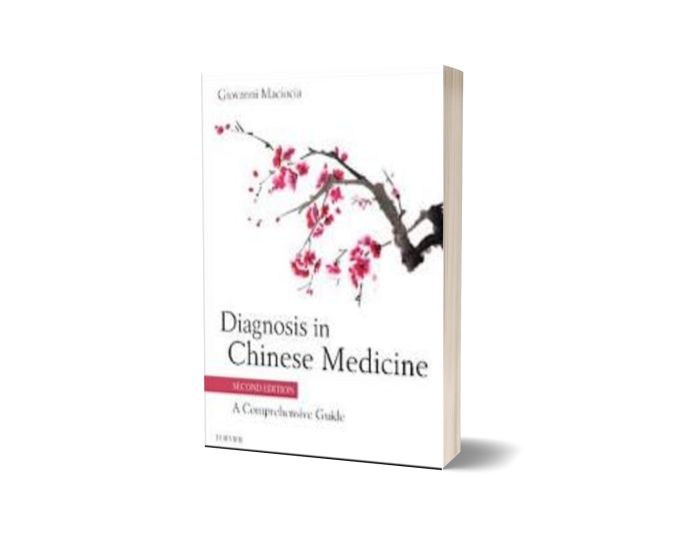We use cookies to make your experience better. To comply with the new e-Privacy directive, we need to ask for your consent to set the cookies. Learn more.
Diagnosis in Chinese Medicine, 2nd Edition
This major, new book is a complete, easily accessed and highly illustrated guide to diagnosis in Chinese Medicine. Emphasis is placed on "real world" issues and symptoms, and the text focuses on clear interpretations of signs and symptoms - the practice beyond the theory. Since Chinese medicine diagnosis relies on a subjective appraisal of the patient's symptoms and signs - which form a pattern - many factors beyond traditional Western symptoms are taken into consideration e.g. a patient's voice, the absence of thirst, feeling hot or cold, the patient's smell, tone of voice, glitter of eyes. Thus, Chinese diagnosis is based on a subtle appraisal of a patient's disharmony, which may not be a "disease" at all, and as such requires careful interpretation of a range of nuances. This book will help lead students and practitioners through basic on to sophisticated levels of diagnostic interpretation
Key Features
- One-of-a-kind text gives you a clinical understanding of Traditional Chinese Medicine.
- Rich, unique content offers an unparalleled depth of information that is meticulously cross-referenced.
- Includes all the signs and symptoms that a modern patient may present in the clinic, no matter how subtle.
- Outlines the decision-making options in key situations to help you through the most challenging topics.
- Case histories with diagnoses present common conditions that professionals will often find in practice.
- Logically organized to help you quickly find the information you need in clinical situations.
- Written by a leader in the field of Chinese medicine provides you with an expert's clinical experience and understanding.
New to this Edition
- NEW! Clinical and Treatments notes provide practical information on acupuncture - including herbal treatment, when appropriate - for most symptoms and signs, giving the book a clinical application in therapy.
- NEW! UPDATED full-color design and color photographs depict external clinical signs for more accurate clinical recognition.
- NEW! Learning outcomes summarize the basics that you should know after completing a chapter.
- NEW! Thoroughly updated content from an expert author clarifies the best practices for diagnosis in Traditional Chinese Medicine.
As Giovanni Maciocia says in the preface to this vast and comprehensive textbook "The longer I practise, the more I appreciate the importance of diagnosis to Chinese medicine in particular and to medicine in general. Indeed, one could say that the value of Chinese medicine lies not in its theories of Yin-Yang, Five Elements, Eight Principles, etc., but in diagnosis itself".
Whilst this may seem self-evident, what he is referring to is the extraordinary focus on, and expertise in, the arts of observation and examination that form one of the richest parts of Chinese medicine, and which have so declined in modern western medicine. A traditional medicine, the major part of whose history predates modern biomedical diagnostics, has only the human senses to rely on, and the science and art of Chinese medicine diagnosis concerns itself with everything that can be seen, smelt, palpated, heard and asked about. How comprehensive this knowledge is, is illustrated by the breadth of this monumental work that goes so much further than anything yet published in English on this subject.
The book is divided into 5 major parts: diagnosis by observation, diagnosis by interrogation, diagnosis by palpation, diagnosis by hearing and smelling, and symptoms and signs. Several of these parts are subdivided into sections, and then each section is further subdivided into chapters (there are 111 chapters in the whole book). Thus section one (diagnosis by observation) is subdivided into i. observation of the body, mind and complexion, ii. observation of parts of the body, and iii. tongue diagnosis. The first of these (observation of the body etc.) has chapters on observing body shape (according to yin and yang, according to the five elements, according to prenatal and postnatal influences, according to body build, according to pain and drug tolerance), observing the mind, spirit and emotion (the three aspects of the spirit, the three conditions of the spirit, the spirit and constitution, the spirit and the emotions), observing the complexion and so on.
Section 5, Symptoms and signs, is the largest, and the previous sections frequently refer to it. For example, diagnosis by observation of the neck illustrates and gives brief differentiations of variations in neck length and width, neck rigidity, soft neck, deviated neck etc. Similarly, diagnosis by interrogation covers goitre and pain and stiffness of the neck. In both cases, however, for each disorder or pattern the reader is referred to a chapter in section 5 where a full discussion of the presentation is given (pattern, symptoms and signs, pulse etc.). For a book of this size, it would have been more helpful here to refer readers to the relevant page number in section 5, as it can take a bit of time to track down the right passage in the text.
It is hard in a review to convey the immensity of this book. It can really only be repeated that nothing as ambitious has been attempted in English before, and that it is inconceivable that anyone studying or practising Chinese medicine can afford to be without it.
Peter Deadman
| Author | Giovanni Maciocia, CAc(Nanjing) |
|---|---|
| Publication Date | 1 Mar 2018 |
| Publisher | Churchill Livingstone |
| Number of Pages | 1128 |
| Book Format | Hardback |
* Orders shipped outside of Europe are eligible for VAT relief and will not be charged VAT.


